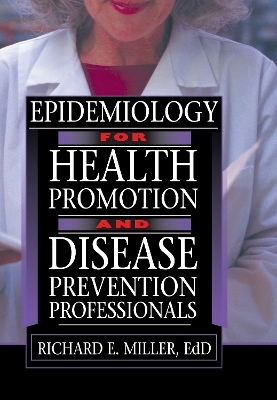
Epidemiology for Health Promotion and Disease Prevention Professionals
Routledge (Verlag)
978-0-7890-1598-3 (ISBN)
Every day, health promotion and disease prevention professionals interact with epidemiologists during the course of their practices. Investigations into the causes, distribution, and control of disease provide practitioners in the public and allied health fields with findings essential to dealing with patients and clients. This ongoing collaboration makes the need for communication through a common body of knowledge a matter of life--and death.
Epidemiology for Health Promotion and Disease Prevention Professionals presents you and your students with practical applications that incorporate up-to-date epidemiological findings into health promotion and disease prevention concepts. The book establishes an operational understanding not only for students in the public health, nursing, medicine, and environmental health fields, but also for future and current health and patient educators, fitness and exercise science specialists, and athletic and personal trainers. This comprehensive textbook includes a step-by-step guide to the epidemiological process, including surveillance and investigation, how studies and trials are conducted (and categorized), and how findings are used to plan, implement, and evaluate health promotion and disease prevention programs.
Epidemiology for Health Promotion and Disease Prevention Professionals includes:
problem-solving strategies for investigations and studies
chapter-ending knowledge tests that target health improvement and disease prevention
Epidemiology for Health Promotion and Disease Prevention Professionals provides students in the health, medical, and fitness fields with the working knowledge of epidemiology they will need as professionals and provides professionals with an understanding essential to their practices.
Richard E Miller
Preface
Acknowledgments
Chapter 1. Introduction to Epidemiology
What Is Epidemiology?
What Is Health Promotion and Disease Prevention?
How Is Epidemiology Conducted?
How Are Epidemiological Findings Used?
Summary
Review Questions
Web Site Resources
Chapter Activities: Knowledge Tests on Healthy People 2010
Focus Area 1: Access to Quality Health Services
Focus Area 2: Arthritis, Osteoporosis, and Chronic Back Conditions
Test Answers
Chapter 2. Historical Perspectives
History and Epidemiology
Parents of Epidemiology
Honorable Mentions of the Twentieth Century
Recent History of Public and Environmental Health
Summary
Review Questions
Web Site Resources
Chapter Activities: Knowledge Tests on Health People 2010
Focus Area 3: Cancer
Focus Area 4: Chronic Kidney Disease
Test Answers
Chapter 3. Concepts and Principles
Disease Occurrence and Distribution
Disease Cause and Control
Disease Prevention and Treatment
Summary
Review Questions
Web Site Resources
Chapter Activities: Knowledge Tests on Health People 2010
Focus Area 5: Diabetes
Focus Area 6: Disability and Secondary Conditions
Test Answers
Chapter 4. Agents
Biological Agents
Chemical Agents
Physical Agents
Social Agents
Behavioral Agents
Genetic Agents
Summary
Review Questions
Web Site Resources
Chapter Activities: Knowledge Tests on Health People 2010
Focus Area 7: Educational and Community-Based Programs
Focus Area 8: Environmental Health
Test Answers
Chapter 5. Person, Place, and Time
Introduction
Person Characteristics
Place Characteristics
Time Characteristics
Summary
Review Questions
Web Site Resources
Chapter Activities: Knowledge Tests on Health People 2010
Focus Area 9: Family Planning
Focus Area 10: Good Safety
Test Answers
Chapter 6. Disease Process
Diseases and Morbid Conditions
Infectious Disease Application
Noninfectious Disease Application
Morbid Condition Application
Summary
Review Questions
Web Site Resources
Chapter Activities: Knowledge Tests on Health People 2010
Focus Area 11: Health Communication
Focus Area 12: Heart Disease and Stroke
Text Answers
Chapter 7. Surveillance
Introduction
Surveillance Systems
Rates
Summary
Review Questions
Web Site Resources
Chapter Activities: Knowledge Tests on Health People 2010
Focus Area 13: HIV
Focus Area 14: Immunization and Infectious Diseases
Test Answers
Chapter 8. Investigations
Investigative Methods
Problem Solving During Infectious Disease Outbreaks
Investigating Noninfectious Disease Epidemics
Investigating Chronic Diseases
Summary
Review Questions
Web Site Resources
Chapter Activities: Knowledge Tests on Health People 2010
Focus Area 15: Injury and Violence Prevention
Focus Area 16: Maternal, Infant, and Child Health
Test Answers
Chapter 9. Prevalence Studies
The Nature of Studies
What is Prevalence?
Summary
Review Questions
Web Site Resources
Chapter Activities: Knowledge Tests on Health People 2010
Focus Area 17: Medical Product Safety
Focus Area 18: Mental Health and Mental Disorders
Text Answers
Chapter 10. Retrospective Studies
Case Study
Case Control Study
Summary
Review Questions
Web Site Resources
Chapter Activities: Knowledge Tests on Health People 2010
Focus Area 19: Nutrition and Weight Management
Focus Area 20: Occupational Safety and Health
Test Answers
Chapter 11. Prospective Studies
Summary
Review Questions
Web Site Resources
Chapter Activities: Knowledge Tests on Health People 2010
Foc
| Erscheint lt. Verlag | 13.9.2002 |
|---|---|
| Verlagsort | New York |
| Sprache | englisch |
| Maße | 148 x 210 mm |
| Gewicht | 1040 g |
| Themenwelt | Medizin / Pharmazie ► Medizinische Fachgebiete |
| Studium ► Querschnittsbereiche ► Epidemiologie / Med. Biometrie | |
| ISBN-10 | 0-7890-1598-6 / 0789015986 |
| ISBN-13 | 978-0-7890-1598-3 / 9780789015983 |
| Zustand | Neuware |
| Haben Sie eine Frage zum Produkt? |
aus dem Bereich


